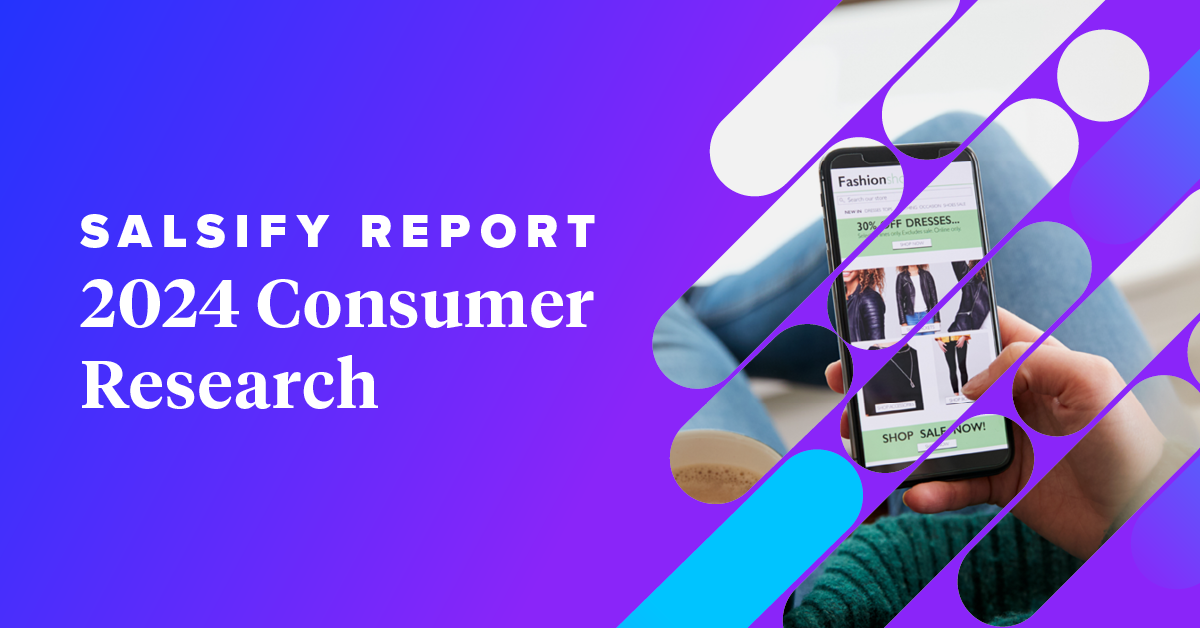

Meet More Customer Expectations
Download Salsify’s “2024 Consumer Research” report to learn how you can adapt your shopping experiences to meet customer expectations.
DOWNLOAD REPORTPIM
Manage all product content in one central system of record.
Syndication
Easily syndicate product content to every consumer touch point.
Enhanced Content
Enrich product pages with below-the-fold content and rich media.
Intelligence Suite
Bring AI-powered capabilities directly into your Salsify workflows.
Grocery Accelerator
Leverage the first-ever category-wide PXM accelerator in the grocery industry.
GDSN Data Pool
Synchronize standard supply chain, marketing, and ecommerce attributes globally.
Digital Shelf Analytics
Continuously optimize your organization’s product content syndication.
Catalog Sites
Share secure, on-brand, and always up-to-date digital product catalogs.
Automation and AI
Automate business processes and enhance Salsify workflows with AI.
PXM Platform, Integrations, and APIs
Integrate the PXM platform with the rest of your enterprise systems architecture.
Supplier Onboarding
Accelerate supplier onboarding while ensuring your schema requirements are met.
Product Listing
Sell products faster with Product Listing.
Content Enrichment
Increase online conversions with Content Enrichment.
Automation
Save time and increase operational efficiency with retail automation.
SXM Platform, Integrations, and APIs
Integrate the SXM platform with the rest of your enterprise systems architecture.
Syndication Network
Automate how you exchange product content data to the digital shelf.
Enhanced Content Network
Turn product pages into product experiences with Enhanced Content.
Commerce Platform Integrations
Create winning product experiences everywhere shoppers are, including on owned sites.
GDSN Data Pool
Synchronize standard supply chain, marketing, and ecommerce attributes globally.
Open Catalog
Connect to the digital shelf faster with an open, standardized, and free product catalog.
Resources
Resource Library
Explore our ecommerce resources to get everything you need to win on the digital shelf.
Blog
Read our blog to get actionable insights for navigating changing markets and industry demands.
Webinars
Watch our on-demand ecommerce webinars to gain expert advice and tips from our community of industry leaders.
Customer Blog
Gain the latest tips, industry trends, and actionable ecommerce insights.
Knowledge Base
Investigate our knowledge base to build your Salsify skills and understanding.
API
Examine our comprehensive API and webhook guides to start working with Salsify quickly.

Download the report to get expert insights, consumer research, and top industry trends.

Brands can create beautiful content featuring well-lit product photos and dazzling descriptions, but it’s not always enough to win consumers’ hearts.
Many shoppers have a healthy amount of skepticism when it comes to brand-provided images and descriptions, but user-generated content (UGC) can sway them in a positive direction.
Content generated by consumers has the authenticity that brands sometimes lack. UGC offers consumers a first-hand take on products from real people — helping them make a final decision (and purchase).
Here’s a breakdown of the fundamentals of UGC, tips for using it to your advantage, and three examples of user-generated content expertly executed.
User-generated content (UGC), also known as consumer-generated content, is content created by consumers to discuss a brand’s product or services.
UGC isn’t limited to one content type and typically includes:
These content types can be broken down into three different categories: blogs, social media, and customer reviews and testimonials.
Omnichannel commerce has created a nonlinear shopping journey that puts customers in the driver’s seat. They have a wealth of options at their fingertips and can afford to be choosy. This doesn’t always bode well for customer loyalty.
Building consumer trust is the best method for improving loyalty, but it needs to be gained strategically and organically.
According to Salsify’s “2022 Consumer Research” report, 30% of German shoppers, 44% of French shoppers, 46% of U.S. shoppers, and 47% of shoppers in Great Britain will pay more for a brand they trust — so it’s worth the effort.
Word of mouth is one of the most powerful tools a brand can use to promote its products. Media research company Nielsen backs this up: 88% of consumers trust recommendations from people they know over any other sources.
UGC is essentially word-of-mouth marketing, and it can be highly effective for driving conversions. According to PowerReviews, UGC can influence customers to convert at a rate that’s 102.4% higher than average.
Brands are catching on to the effectiveness of UGC, and some are even providing incentives for consumers to create content.
While there are many different types of UGC, here are three of the most popular ones with tips for capturing consumers on each.
Instagram has a built-in UGC feature that allows brands to source UGC from content creators on the platform.
When a brand is tagged in a user’s post, the brand can ask permission to repost the user’s content. Creators can approve or deny the brand’s request. If approved, the content can be used in brand-owned spaces like the brand’s Instagram shop.
Statista forecasts that Instagram users will reach 1.44 billion monthly users by 2025, accounting for 32.1% of global internet users.
Now is the time to reinforce your brand’s presence on Instagram with excellent UGC.
Learning how to properly use UGC on Instagram will give your brand an air of authenticity that can’t be achieved otherwise.
Consider this Statista stat: A micro-influencer (someone who has 100,000 to 1 million followers) receives an average of 38,517 views on one TikTok video. That’s 38,517 potential customers — the kind of number that can make a product go viral and sell out.
There are various social media marketing strategies you can employ to get the most out of your TikTok UGC.
For example, you can hold a contest that will reward the best content creator with a prize. You’ll get tons of videos that you can repurpose in marketing campaigns, and the winner will be rewarded by one of their favorite brands. It’s a win for everyone involved.
You can also create a specific hashtag for creators to use whenever they create content about your brand. If you have a social media marketing team, they can routinely check the hashtag for any noteworthy content. You can also use the hashtag to see if people are sharing negative experiences about your brand and do damage control.
Partnering with influencers is also an excellent way to prompt UGC for your brand. For example, you can send them PR packages for an unboxing video or to promote a product before it comes out.
TikTok is a platform built on user-generated content. If you don’t already have a TikTok profile, it’s worth pursuing.
YouTube is where people turn for authentic, honest product reviews. Typically, YouTube allows for longer reviews than TikTok and Instagram, so consumers turn to this platform for more in-depth information.
According to research firm Morning Consult Pro, Generation Z holds YouTube influencers in the same reverence as celebrities. Additionally, influencers are more trustworthy than celebrities to 50% of millennials.
Brands that want to capitalize on this opportunity should narrow down YouTubers who fit their brand aesthetic and send them products for review. You can also ask influencers to produce how-to videos that you can repurpose on your brand’s channel.
Customer testimonials from real customers who are excited about your products are also great to feature on your channel. This will help increase brand trust and awareness.
If customers share feedback in the comments, you can address their comments and show that you care about their experience with your brand.
Here are three examples of user-generated content companies use to their advantage.
Makeup retailer Sephora has an extensive portion of its product pages dedicated to customer reviews. The retailer recognizes that makeup is a complex product to purchase without physically trying it on, so they bridge the gap with UGC.
Image Source: Sephora
In addition to pictures, reviewers include details about their eye color, hair color, and skin tone and type. This allows shoppers to search for the characteristics that best match their own and gives them confidence in their purchase.
Homeware brand Le Creuset took note of a TikTok creator who tagged them in a cooking video where their product was highlighted. The brand reached out to the creator in the comments and asked for permission to share the video on their social channels with a promise to credit the creator.
@kristiananoel I have a thing where I dont like disliking foods so ill usually try anything once and keep trying it until I like it #mollybaz #cookthisbook #congee #porridge #tumeric #soupgirl #lecreuset #materialkitchen #citarellanyc #getgraza #nycapartment #brooklyn
♬ Caramel Latte - Prod. By Rose
Video Source: Kristiana Noel TikTok
The creator responded in the comments granting their permission. This is a perfect example of a UGC brand/creator interaction. Le Creuset gains free content, and the creator is promoted on the brand’s official channels.
Clothing brand Madewell boasts, “You look great in our jeans, and here’s proof,” with images to back it up. The brand highlights four different content creators modeling Madewell denim on the homepage. Each content creator’s Instagram handle is listed at the bottom of the images, and clicking on their pictures brings you to the denim section of the website.Image Source: Madewell
This brilliant tactic puts content creators front and center while also driving customers further down the path to purchase.
If you’re interested in using UGC for your marketing campaigns, begin by checking out any mentions of your brand on social media. You may already have a wealth of options to begin with.
By repurposing UGC, you’ll give shoppers the authentic experiences they want, strengthen existing customer relationships, and gain customer loyalty.

Download Salsify’s “2024 Consumer Research” report to learn how you can adapt your shopping experiences to meet customer expectations.
DOWNLOAD REPORTMadeline Koufogazos (she/her) is an editor and writer at Salsify, based out of Boston. She enjoys sharing her insights on consumer trends and behaviors, commerce, media, pop culture, and travel.
Standing out on the digital shelf starts with access to the latest industry content. Subscribe to Below the Fold, our monthly content newsletter, and join other commerce leaders.